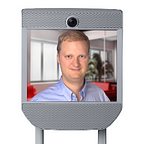What it means to have remote presence
At Suitable Technologies, we’re working to develop a new product for something we call remote presence.
People often ask what exactly we mean by “remote presence,” how it differs from telepresence, videoconferencing, or Skype, and why we don’t call it a robot. For example, is a cell phone a remote presence device? And why is the distinction important?
Remote presence refers to a system or device that enables people separated by distance to communicate, collaborate, and understand each other as if they shared the same physical space, without losing effectiveness over time.
Remote presence is still a fairly new concept, but the team at Suitable (and previously, Willow Garage) has already spent years researching and understanding how it can change the ways people work and communicate. Early research prototypes, such as BiReality (HP Labs) and PRoP (UC Berkeley) demonstrated a lot of the promise of remote presence, but not in a way that was cost-effective or reliable for general use. We’ve used several generations of these devices ourselves, and now have many employees who rely on them daily.
Many devices or products can create a feeling of remote presence for a short period. For example, computer video chat can bring someone remote into a meeting, or a live television broadcast can make viewers feel like they’re seeing an event in person. However, none of these could be said to have a permanent effect. Eventually, the illusion fades.
A remote presence device can be used constantly or intermittently, but always conveys an authentic feeling of “being there”, for parties on both sides. Furthermore, when using a remote presence device, the operator, or “pilot,” should never feel disadvantaged, or handicapped, compared to humans at the same location, or “locals.”
These are the key components of being there:
Ability to move freely
You must be able to move in all directions, at human speed. Anywhere people can go, you can too. When people move, you can stay with them.
Not needing to ask for help
You can get through a normal day without assistance from anyone. Requiring help, even for small tasks, will quickly erode any feelings of autonomy, and create a burden for the locals who must constantly assist you.
Visual awareness
You can see what a person can see, not only in terms of focus, but also peripheral awareness. Having a narrow focus (as many cameras do) leads to tunnel vision, which feels like a significant disadvantage compared to local people.
Audial awareness
You can hear what a person can hear. This requires clear, spatialized audio, so you can pick out sounds and know where they’re coming from. You can have long conversations without any noticeable fatigue.
Human size
To feel like a person, you must be treated like a person. And to be treated like a person, you must look like a person. Humans have developed sophisticated forms of non-verbal communication, such as posture, showing focus, and movement. True presence requires that you be able to participate in this communication.
Reliability
The only tools that will become a regular part of your life are the ones you can count on, every time. This is especially true for remote presence, where the tool represents your very existence. An unreliable system is simply intolerable.
To learn more about why we believe Beam is the most effective remote presence device on the market today, and how our design addresses each of these components, continue reading over on our company blog.
